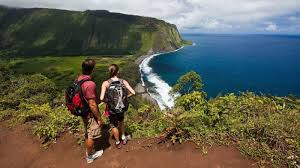Friday, March 1, 2024

Ten residents from the Kaʻū community were honored at a hō‘ike event held in Pāhala for successfully finishing the “Ka‘ū Hoa Pili ‘Āina” program. This four-month initiative, centered on land-based education, is a component of the Hawai‘i Tourism Authority’s (HTA) efforts in destination management and the Hawai‘i Island Community-Based Action Stewardship Program.
“The Ka‘ū community voiced the need to better manage tourism impacts on the natural resources in Punalu‘u through place-based curriculum,” said Mufi Hannemann, HTA Board Chair who spent part of his career working in Pāhala and living in Nāʻālehu. “We thank Ka ‘Ohana O Honu‘apo for facilitating this community effort and the work of these local stewards to ensure the protection and preservation of this special place.”
The “Ka‘ū Hoa Pili ‘Āina” program, led by the non-profit organization Ka ‘Ohana o Honu‘apo headquartered in Nā‘ālehu, centered on recruiting and training ten local stewards. The program emphasized the principles of mālama ‘āina, integrating cultural practices, conservation, biological sciences, and place-based messaging specific to the Ka‘ū region.
“It’s important to HTA that we continue to listen to our residents and support the collaborative initiatives they want to see within their communities,” said Daniel Nāho‘opi‘i, HTA’s interim president and CEO. “Mahalo to these stewards for committing themselves to the rigors of the training and the stewardship of their home moku (district), Ka ‘Ohana O Honu‘apo for their leadership and collaboration, and the many kumu and organizations for providing their mana‘o in this process.”
The Ka‘ū Hoa Pili ‘Āina program receives funding from HTA as part of its commitment to destination stewardship and community initiatives, in alignment with the Hawai‘i Island Destination Management Action Plan (DMAP).
“This pilot program is a partnership with the community to support place-based, kamaʻāina and visitor education efforts while mitigating user impacts in Punalu‘u and the greater Ka‘ū area,” said Rachel Kaiama, Island of Hawai‘i Visitors Bureau’s (IHVB) destination manager.
During the training, Ka ‘Ohana o Honu‘apo collaborated with 13 other organizations to offer insights on various topics. These included the Hawai‘i Wildlife Fund, Nā Mamo O Kāwā, Kua‘āina Ulu Auamo (KUA)’s Limu Hui, The Nature Conservancy, Hawai‘i Volcanoes National Park, Kalanihale, Hui Aloha Kīholo, Edith Kanaka‘ole Foundation, Kamehameha Schools, Volcano Rare Plant Facility, Kaulana Mahina, Island CPR, and Mālama Pono Punalu‘u.
Trainees explored subjects such as land-use changes, watershed protection, heritage management, and coastal restoration projects. They underwent CPR and First Aid training and acquired communication skills to convey the importance of pono practices to visitors and kama‘āina.
In addition to species identification and monitoring practices, trainees engaged in fieldwork, including ʻopihi monitoring and limu surveys. They participated in forest and loko i‘a (Hawaiian fish pond) restoration, marine debris removal, community-based management, communication skills development, mo‘olelo sharing, and learned about watershed impacts.
A representative from Ka ‘Ohana o Honu‘apo emphasized that the training aimed to steward the entire district of Ka‘ū, rather than focusing on one specific place or ʻāina. It was designed as a comprehensive, landscape-scale program.
“The trainees learned a great deal about the resources within Kaʻū, plus land-use changes over time, the impacts of climate change, invasive species, etc., and heard from experts in their fields relative to conservation and stewardship,” detailed the Ka ‘Ohana O Honu‘apo representative. “They also formed collaborations and partnerships with other organizations and community members, which opened up the potential to learn and incorporate stewardship activities not yet happening in Kaʻū.”
One highlighted stewardship opportunity involved learning from the success of community-based management in Miloliʻi and exploring ways to implement similar practices along the Kaʻū coastline. Trainees also delved into studying the impacts of Rapid ʻŌhiʻa Death on Hawai‘i’s forests and explored methods to mitigate its spread through decontamination strategies and protocols.
Trainees received a monthly stipend for their participation and were required to attend all instructional events and stewardship-related opportunities. They were also tasked with engaging visitors to effectively convey appropriate behaviors and safety protocols. Additionally, they eagerly participated in a variety of volunteer activities with numerous groups and organizations across Ka‘ū and South Kona. Trainees hailed from various areas within the Kaʻū District..
Sharing how the stewardship program has directed her “to a purposeful life,” trainee Chelsae-Lynn Kobzi said the best part of the program was working with organizations and “seeing whatʻs available out there as there is so much to do.” She added participation has “brought me purpose, confidence and a whole new perspective.”
Having developed a stronger bond with their ‘āina, the recently established group of stewards can endeavor to reestablish connections with the various organizations and individuals they collaborated with during their training. They can sustain involvement in initiatives aimed at caring for the land, whether through volunteer work or employment opportunities.
Looking to the future, Kaiama said the idea for the training program is to show how community stewardship training and implementation can be done and then hope for more like it to be self-sustained or partially-supported by state and county agencies.
“It would be ideal for community-based steward programs to foster the economic job diversification we need as these volunteers and others like them can benefit from well-paying jobs that uplift their community while protecting the natural and cultural resources of the island,” added Kaiama. “This is the regenerative tourism model we would like to see more of.”
Supported financially by HTA and overseen by IHVB, the Hawai‘i Island Community-Based Action Stewardship Program expands upon the achievements of similar community-driven initiatives across the state, such as those at Hanauma Bay State Park, Hā‘ena State Park, and Lē‘ahi (Diamond Head State Monument).
Tuesday, April 30, 2024
Monday, April 29, 2024
Tuesday, April 30, 2024
Tuesday, April 30, 2024
Monday, April 29, 2024